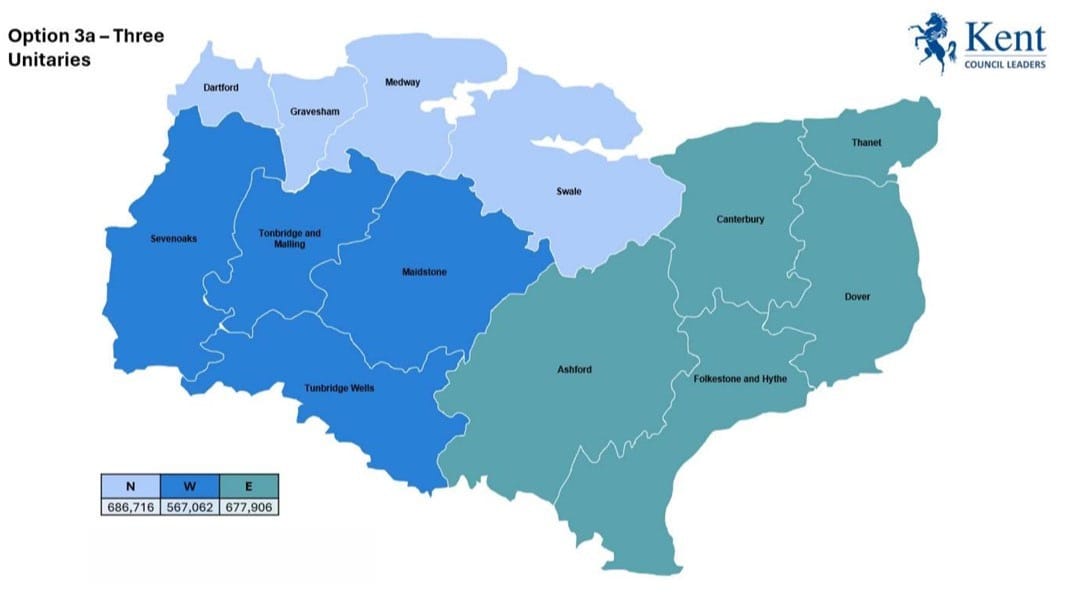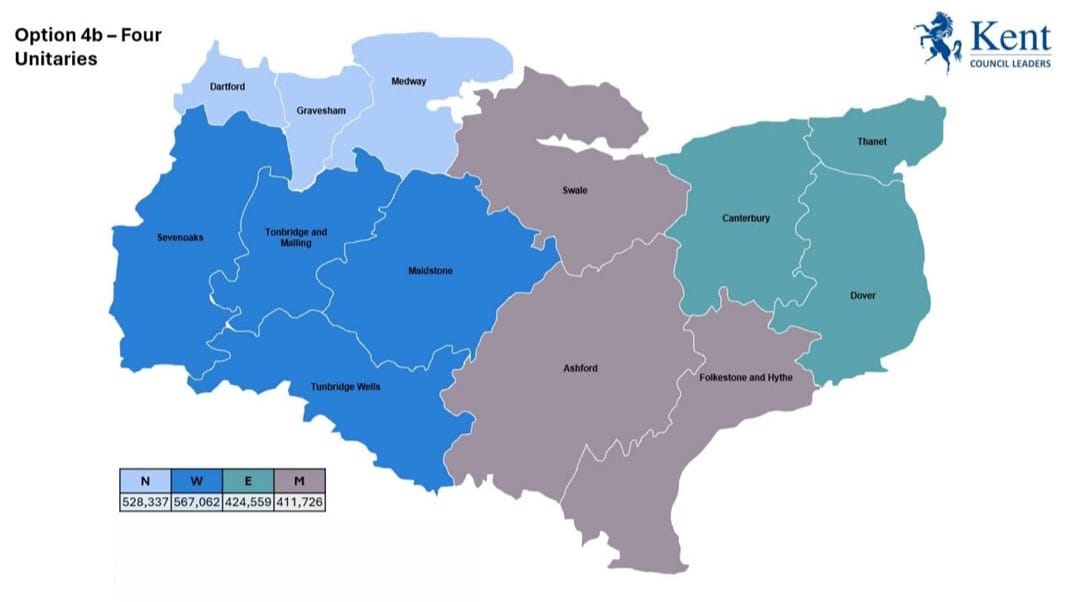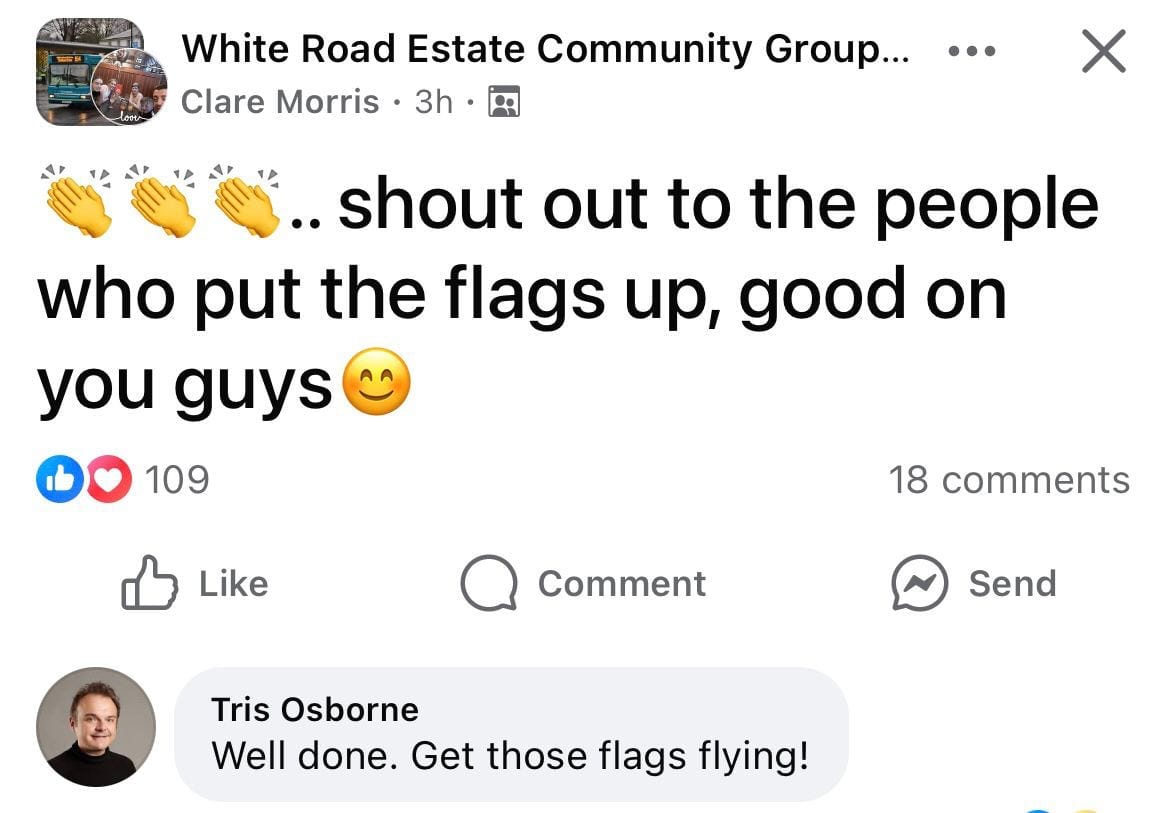The fight over Medway’s HMOs
Plus two Kent maps left standing, MP supports flag erections, news in brief, and more

HMOs have become an increasingly fraught debate in Medway and nationwide in recent months. Landlords argue that single houses with five or six residents fill a need, while neighbours complain about stretched services and transient communities. We’ve been taking a look at what it all means. Further down, we have the latest news about local government reorganisation, with Medway’s proposal shunned and two others being taken forward. Finally, at least one Medway MP supports the flag erections in our towns, news in brief, and more.
Thanks to the hundreds of you who have completed our reader survey. Every response gives us valuable insight into who reads this thing and what they want from it, so please take part if you haven’t already. It’s one page, all questions are optional, and it’ll take less than five minutes to complete.
The fight over Medway’s HMOs
Houses in Multiple Occupation (or HMOs) are the catch-all term for properties where several tenants share kitchens and bathrooms but rent their rooms individually. They can be anything from a converted family terrace with six students to a larger block carved into dozens of bedsits. They’re cheaper and more flexible than most flats, but often come with cramped layouts, fraught neighbours, and a reputation for lowering the tone of a street.
Medway has 255 licensed HMOs. That’s more than triple Gravesham, six times Swale, and the rate of new ones seems to be accelerating. Eight new applications landed on Medway Council’s planning portal in August alone. Two more have arrived this week. Most are in Gillingham or Chatham, but now they’re spreading to Darland and even Upnor, where they tend to be even more controversial.
It isn’t just Medway. Councils across the country are trying to get a grip. Some councils are trying to ban them altogether. Some, like Wandsworth, are licensing, prosecuting, and clawing money back from rogue landlords. Even areas like Lambeth have tightened the rules. A few weeks ago, The New Statesman described the impact HMOs have on communities.
Medway’s approach? A bit of everything and not much of anything.

At the end of Gillingham High Street, a planning application was made to cram a 30-bed HMO onto the site of the fire-damaged nursery on the edge of the Great Lines. Two kitchens, four living rooms, no parking, token gardens. Councillors refused it.
But at Selbourne Road, the council waved through a seven-bed HMO despite a petition from 60 neighbours. The planning committee tied 6–6, and chair Cllr Chrissy Stamp admitted they’d probably lose on appeal if they said no, so she voted yes. A resident of fifty years called it “devastating”.
Gillingham and Chatham, between them, have more than 150 HMOs. Rochester and Strood have 31. Rainham barely registers. However, as HMOs proliferate, areas that previously avoided them are seeing them arrive.
The issue is becoming increasingly political. Reform pounced on plans in Upnor to convert part of the former Arethusa Venture Centre into an 11-bed scheme. Rochester and Strood’s branch staged a public meeting and thundered about how “profit-driven HMO developments are threatening the character, safety, and spirit of our neighbourhoods.” Within days, Facebook users on local Facebook groups were making ‘jokes’ about migrants arriving in dinghies in the river in anticipation of the new HMO.
It’s not an issue only Reform is highlighting though. “The rate and scale of HMO conversions in Gillingham have reached an unsustainable level and are now negatively impacting our local community,” said Labour MP for Gillingham and Rainham, Naushabah Khan, in a joint statement with Cllr Louwella Prenter, Medway Council’s Portfolio Holder for Housing. They stressed HMOs “have a role to play when managed properly,” but warned that too many family homes are being chopped into six-bed lets, piling pressure on local services.
Even the official numbers don’t tell the whole story. The register only covers licensed HMOs. Plenty more operate without permission or licensing, gambling that enforcement won’t catch up. Nobody knows how many.
Meanwhile, the market trundles on. Rightmove currently lists 56 HMO rooms in Medway, anywhere between £400 and £850 a month. That’s just the slice you can see. Others shift directly through letting agents, word-of-mouth, or landlord WhatsApp groups. For some, it’s a last resort. For students in Gillingham, it’s simply how housing works.
This is ultimately why the issue isn’t as straightforward as it initially seems. HMOs are one of the few affordable ways into housing for people squeezed out of the rental market, and they keep the student population close to campus. But poorly converted or badly managed ones can wreck a street. Both things can be true.
Landlords have every incentive to keep going. A three-bed family house turned into a six-bed HMO will earn far more than a single tenancy. Residents can object, councillors can agonise, but without stricter rules, it is in the interests of landlords to keep providing them.
The real issue hangs over all of this, and it’s a perennial Local Authority refrain: Medway hasn’t built enough homes. Major schemes stall, government targets go unmet, and rents keep rising. A growing population is squeezed into housing stock that hasn’t kept up. HMOs end up acting as the safety valve for many.
In central Gillingham, HMOs are so normal they barely raise an eyebrow. In Darland or Upnor, the mere hint of one sets off petitions and public meetings. What passes without comment on Nelson Road feels like an intrusion on the riverfront.
Medway is thousands of homes short. Rents keep climbing. Big regeneration projects are stuck in the mud. And so HMOs will keep filling the gap. Councillors can refuse, campaigners can protest, MPs can demand stronger powers. But until the wider housing crisis is tackled, more applications will land each month, and the register will keep climbing past 255.
The only real question is which street will be next.
Have a Medway story you think we might be interested in? Get in touch via hello(at)localauthority(dot)news - We’re always happy to talk off the record in the first instance…
Medway’s ludicrous borders will outlast the council itself
Local government reorganisation is trundling on, with Medway set to be swallowed up in the process. The latest step has seen consultants KPMG brought in to write the business cases for two possible maps, both of which see Medway folded into something larger.
One would see Medway grouped with Swale, Dartford and Gravesham. The other would send Swale south with Ashford and Folkestone & Hythe, leaving Medway with Dartford and Gravesham. Either way, west Kent’s four councils, who have been angling from the start to be kept together, get exactly what they wanted.

Medway didn’t want things to look like this. The council previously pitched its own four-way model, creating a north-west Kent authority by redrawing a straight line along the M2, meaning areas currently in Tonbridge & Malling got brought into the new authority. That sparked an immediate backlash, with Tonbridge & Malling leader Matt Boughton making it clear that he wasn’t prepared to lose Blue Bell Hill and parts of Walderslade. The plan was then roundly rubbished by other Kent leaders and the Medway Conservatives, who accused the administration of going it alone, mis-selling the idea, and trying to carve up towns and communities with little rhyme or reason. With that proposal firmly ditched, so too is the chance to finally rationalise some of Medway’s more ludicrous borders. Parts of Chatham will continue to be in Maidstone, which remains forever baffling.

The political row over how we got here is unlikely to fade quickly. Medway Conservatives are clear that they want the council to move on from its shunned plan and back one of the two options now being examined by KPMG. The Labour administration at Gun Wharf has mainly gone quiet since its map blew up, with Medway Council leader Vince Maple saying that the council is “now looking at the next steps for Medway ahead of the final submission later this year.”
Done properly, new unitaries could simplify things. They would sweep away the current tangle of county and district councils, ending the duplication and confusion over who runs what. The problem is that the four-way model leaves two authorities well short of the government’s 500,000 population benchmark. That makes the three-way option, with Medway, Dartford, Gravesham and Swale together, look the most feasible, and the one ministers are more likely to sign off.
Kent County Council’s fantasy of a single giant super-council has seemingly also been put to bed. Ministers want submissions by the end of November, and Steve Reed at the Ministry of Housing, Communities and Local Government, who has been in the job for a total of four days so far, will get the final say. The official timeline has any new councils up and running in April 2028.
That might sound a long way off, but the choices being made this autumn will decide what Medway and the rest of the county will look like by then. The odds are that by 2028, we’ll be paying our council tax to ‘North Kent Council.’ Whether it actually makes local government simpler is another matter entirely.
Red, white, and awkward
Another week, another wave of flags sprouting across Medway. This week, it has been chiefly Chatham’s turn, with roundabouts and streets newly decorated in England flags fresh from online wholesalers in China.
With Medway Council taking little action against the first wave of flag erections and graffiti on roundabouts, more have followed. Far-right groups like Britain First, driven out of Rochester a mere decade ago, have even begun appearing in Kent towns, emboldened by the lack of pushback.
Medway Council previously told this publication that it disapproves of the flags but won’t do much about them for now. So it raised eyebrows when Chatham and Aylesford’s Labour MP Tristan Osborne popped up applauding those climbing ladders under the cover of darkness to plant England flags in one of Medway’s most diverse neighbourhoods.

We asked Osborne to confirm he was supporting residents attaching flags to public infrastructure on the White Road estate, given it seemed at odds with the council’s position that doing so is unlawful. He told us:
“The government policy is to celebrate people displaying flags especially for events such as the women’s rugby World Cup taking place at moment. If people want to put them on their own homes and display in public this is welcome. No one owns the flag; it’s a symbol of our shared identity and progressive people should be prepared to own it as I’ve done on my leaflets; on my website and on all my statement; and on my Labour Party membership card!”
All of which is fair enough, but it still didn’t quite answer whether he’s fine with residents scaling council lampposts at night to do it.
In brief
🏨 The King Charles Hotel issued a statement to say they were not housing migrants after a group started planning an anti-migrant march from the Holiday Inn in Rochester to the Gillingham hotel.
➡️ Medway’s three Reform branches have blamed ‘cancel culture’ for having to hold their joint branch event in… Medway. They originally booked the Village Hotel in Medway, which they allege has cancelled their booking, with the event moved to Bridgewood Manor in Chatham. We asked both hotels about the location change, but neither responded.
🏥 An independent report into culture at Medway Maritime Hospital found racism, bullying, and discrimination, with nearly one in ten employees flagging such issues. The trust’s interim chief executive said he was “deeply sorry” and “determined to make changes.”
📚 On the other hand, the same hospital now has a book trolley for the first time in 25 years.
🏘️ A planning application has been submitted to build nine new homes on one plot of land at Sharnal Street near High Halstow.
🚒 Kent Fire and Rescue were called to Boots in Gillingham High Street for what they described as a ‘false alarm,’ a statement that seems somewhat at odds with the photos of smoke pouring out of the building.
More Authority
The French Hospital is a significant yet often overlooked part of Rochester High Street. Steven met their Head of Engagement, Natalie Tegg, in their main office to learn more about the almshouses. They talked about whether it is actually a hospital, how Natalie came to work there and the challenges of the non-profit sector.

Local Authority only exists thanks to our paid subscribers. If you aren’t already one of them and value our work, please consider upgrading your subscription.
Footnotes
Follow us on social media! We’re on Facebook, Instagram, BlueSky, and Threads, but not that other one.
If you enjoy Local Authority, please share it with your friends, family, associates, and even your enemies. We have no meaningful marketing budget, so we rely on word of mouth from our readers to find new readers. You can even get some sweet, sweet rewards for sending new readers our way. Details here.
Music that soundtracked the creation of this edition: If You Leave It Alone by The Wave Pictures, Baroque Anxieties by Little Storping in the Swuff, and The Papas by Spoonboy.






